

International
Labour Organization
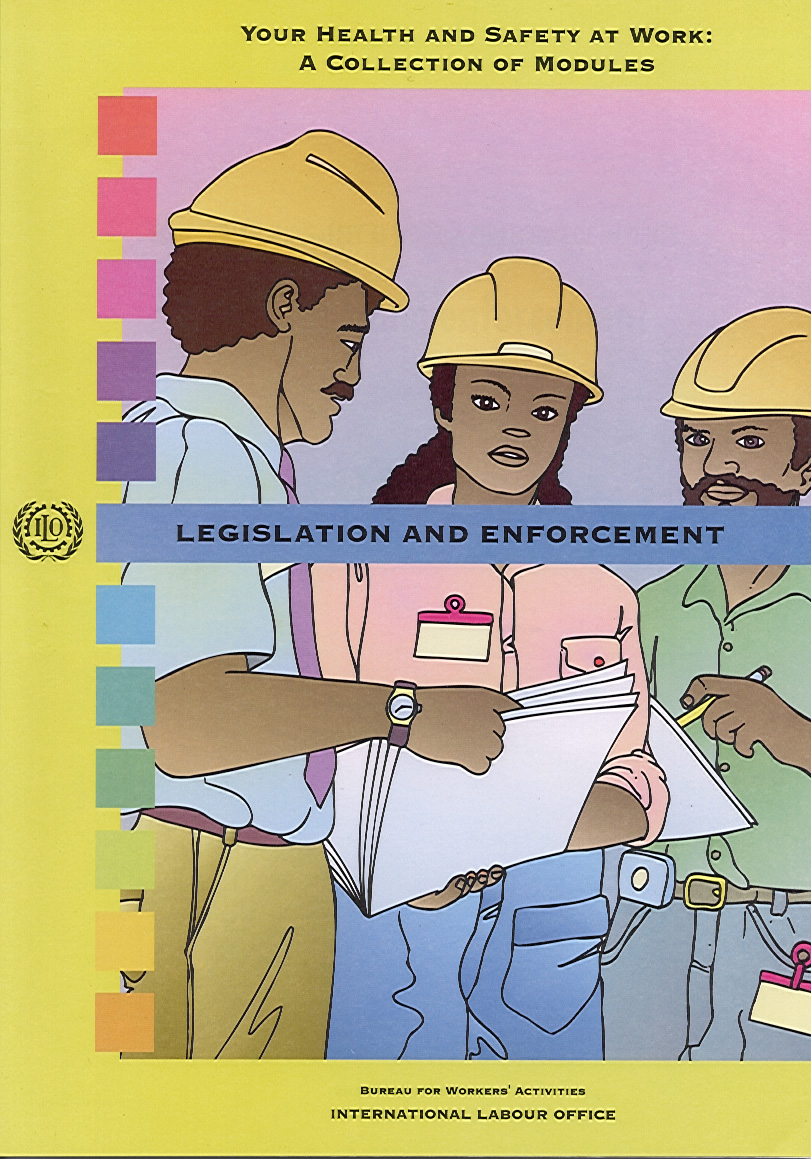 Your health and safety at work
Your health and safety at work
LEGISLATION AND ENFORCEMENT
This Module provides trainees with background information on legislation and enforcement in occupational health and safety. Legislation can include state, provincial or national legislation, or the Conventions or Recommendations of the International Labour Organization (ILO). Topics discussed include: how health and safety law is structured, common limitations of legislation and enforcement in health and safety, how unions can use health and safety legislation to make improvements in the workplace, and the role of the health and safety representative.
At the end of this Module, trainees will be able to:
 |
(1) explain how and where to find information on health and safety legislation that protects them; (2) state several examples of common limitations in legislation and enforcement; (3) explain how laws can be used to establish minimum health and safety standards in their workplaces; (4) state at least one basic right that is included in their country's health and safety legislation (if it exists) and explain how that right can be used to improve health and safety conditions at work. |
Government legislation is what provides workers with minimum standards of health and safety in the workplace. Minimum standards, however, can always be made more protective with stronger legislation. Historically, many trade unions have been successful in pressuring governments to enact health and safety legislation, to make legislation more protective and to enforce the laws. Today it is still important for unions to organize and fight for stronger and more protective occupational health and safety legislation at the national, state or provincial levels.
While health and safety legislation provides the legal backbone to protect workers, it is only effective when supported by government enforcement. Without adequate legal enforcement, some employers do not feel motivated to take workplace regulations seriously, particularly since many governments still do not prosecute employers who violate workplace regulations.
Since many governments do not have enough adequately trained inspectors to inspect every workplace regularly, it is up to workers and unions to be the regular “workplace inspectors” and make sure employers are complying with existing laws and standards. To do this effectively, you must be familiar with the health and safety laws that protect you.
Workers, industry officials, health professionals and government officials all have responsibilities for health and safety. |
 |
 |
|
|
|
Are you familiar with your health and safety rights in the workplace? To learn about your rights, you need to understand the legislation in your country that provides you with these rights.
A. How legislation is structured
The terms used in health and safety legislation may vary in different countries. However, there are some common international terms that you may see in your country's legislation. Four of these terms are: act, regulation, code of practice, guide.
Most countries have acts dealing with occupational health and safety; for example, the Factories Act or the Health and Safety at Work Act. Acts are basically legal statements of the general health and safety principles and responsibilities in a particular country and they are made or approved by the governments or parliaments of individual countries. Acts are fully supported by law, therefore potentially they have a great deal of power, but generally that power is only effective with adequate enforcement. Try to become familiar with your country's health and safety act (if it exists).
Once a health and safety act is passed, then a minister (usually the Minister of Labour), the Cabinet or the state, provincial or even national government will develop detailed regulations. Regulations are fully supported by law so employers are required to comply with them, just like the overall act which they accompany. Regulations tend to cover specific industries or hazards and state the mandatory minimum standards and objectives for hazard control, “safe levels”, training, etc. and they apply to specific workplaces. Regulations cannot be stronger than the act which they accompany. You must become familiar with the health and safety regulations in your country (if they exist) to know more about the specific rights that you are guaranteed.
Codes of practice provide general guidance to employers (and workers) on how to comply with the minimum standards and objectives that are detailed in the regulations. These codes are adopted and amended by a relevant government body, usually within the Ministry of Labour. The ILO develops Codes of Practice which many governments adopt for their guidelines. Although codes of practice are not required by law, they can be used in legal proceedings as evidence.
Guides or notes of guidance provide official detailed technical information and recommendations to help employers comply with health and safety regulations. Guides provide practical “how-to” information for getting into compliance. They are not required by law but they explain the type of action that employers should take to comply with health and safety laws. Guides, like codes of practice, are adopted and amended by relevant government bodies. Governments also can use ILO guides if they have not developed their own.
The ILO produces Codes of Practice, guides and manuals to supplement occupational health and safety Conventions and Recommendations that are developed through the tripartite system of the ILO. These documents are not substitutes for existing national legislation or regulations; rather they provide governments, employers and workers with guidance in health and safety. For a list of relevant Codes of Practice, guides and manuals, see Appendix I at the back of this Module.
B. Where to find your health and safety legislation
You have the right to see the occupational health and safety legislation that applies to you because it is a public document. Try to obtain a copy of your country's legislation and become familiar with the terms used. The terms used in your legislation may be slightly different from the terms discussed above.
Your union is the first place to ask for a copy of the legislation. If they do not have a copy, other sources to ask are: your employer, the local factory inspectorate, the Ministry of Labour, the local library, a lawyer, or a local college or university. When you request a copy of the legislation, ask also for a written summary of the legislation, if one exists. Laws are generally difficult to read and a summary will explain the legal language used in the legislation.
Note: Health and safety legislation is sometimes a section within a different piece of legislation. For example, the health and safety legislation might be included as a section within a Pesticide Act, Factory Act, or a Labour Code, so you may have to look through various pieces of legislation to find the relevant health and safety information.
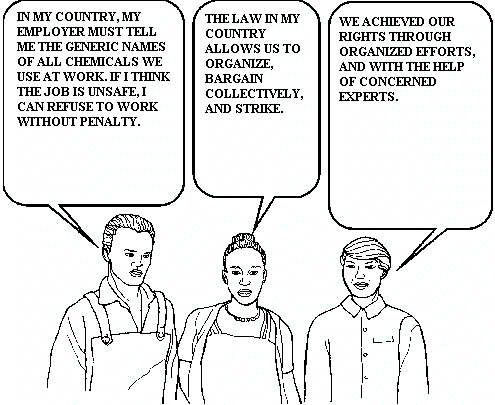
 |
|
1. The legislation in your country is what provides you with your basic rights for health and safety in the workplace. 2. Four general terms commonly used in health and safety legislation are: act, regulation, code of practice, guide. The terms used in your own country's legislation may be slightly different. Try to become familiar with the terms used in your country's legislation. 3. Act:
4. Regulations:
5. Codes of practice:
6. Guides:
7. It is your right to see your country's occupational health and safety legislation. Reading the legislation will tell you what workplace protections are guaranteed to you by law. 8. To get a copy of the legislation, ask: your union, your employer, the local factory inspectorate, the Ministry of Labour, the local library, a lawyer, or a local college or university. Also request any written summary of the legislation that may exist. Health and safety legislation sometimes appears as a section within a different piece of legislation, such as a Pesticide Act or a Factory Act. 9. The ILO produces Codes of Practice, guides and manuals to supplement occupational health and safety Conventions and Recommendations. For a list of relevant Codes of Practice, guides and manuals, see Appendix I at the back of this Module. |
|
Some countries have strong occupational health and safety legislation. However, in many countries the laws are outdated and weak, which means that workers cannot rely on legislation for adequate protection.
Many trade unions have identified a number of limitations in the health and safety legislation in their countries. Common limitations include the following:
Ideally, legislation should:
What are the limitations in your county's health and safety legislation? Improving health and safety laws and making sure that they address technological, economic and social changes is a continuous process for workers and unions in every country.
Health and safety legislation needs government enforcement in order for it to be effective. In many countries, however, there are serious limitations in the way the laws are enforced.
Government inspectors are needed to inspect, monitor and enforce the law in workplaces. These inspectors are known as health and safety inspectors or factory inspectors and are under the authority of the Ministry of Labour or the equivalent. Inspectors should make sure that employers comply with the minimum legal health and safety standards. However, their authority is limited to the extent of the legislation; weak and ineffective legislation gives inspectors little authority, and the result may be little or no action to improve working conditions.
The health and safety inspector can help workers and supervisors to identify unhealthy or unsafe working conditions. |
 |
Many trade unions have identified a number of problems with the enforcement of health and safety legislation in their countries. Common problems include the following:
Ideally, adequate enforcement should:
Because of the serious problems in enforcing health and safety laws, it is better to use your union and negotiations as your first line of defence against poor working conditions and to rely on inspectors only as a back-up.
 |
Points
to remember |
|
|
IV. How to use health and safety legislation
Once you are familiar with your health and safety legislation, you can make use of it by developing a check-list from the act or the regulations. The check-list will consist of simple questions to help you identify areas in the workplace that are not in compliance with existing regulations. A check-list also can be used as a basic summary of the laws.
Study the law and determine what rights you have. Make a poster for the workplace and union hall. |
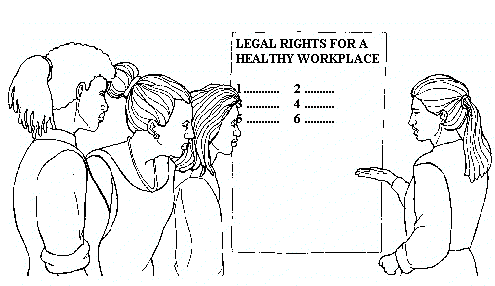 |
It is not realistic to put together a check-list on all of the legislation that applies to your workplace, so you should select the most important general hazard areas. For example, you could develop a check-list from the regulations on “cranes and hoists”, “scaffolding”, “storage of chemicals”, or any other area that you think is particularly important. You could also develop check-lists to use before or during inspections to help you or an inspector focus on problem areas.
Here are some simple rules for preparing a check-list:
The following is an example of how to develop a check-list based on a sample of health and safety legislation — ILO Convention No. 155 concerning occupational safety and health and the working environment, Part IV: Action at the level of the undertaking, Articles 16 and 19. (Copies of Convention No. 155 and Recommendation No. 164 are attached as Appendix II at the back of this Module. See the Glossary in the Instructor's guide to the Modules for more information about ILO Conventions and Recommendations.
Health and safety legislation can always be strengthened to provide workers with more protection. As you read this Convention, can you think of some suggestions for strengthening it?
Part IV. Action at the level of undertaking
Article 16
Employers shall be required to ensure that, so far as is reasonably practicable, the workplaces, machinery, equipment and processes under their control are safe and without risk to health.
Employers shall be required to ensure that, so far as is reasonably practicable, the chemical, physical and biological substances and agents under their control are without risk to health when the appropriate measures of protection are taken.
Employers shall be required to provide, where necessary, adequate protective clothing and protective equipment to prevent, so far as is reasonably practicable, risk of accidents or of adverse effects on health.
Article 19
There shall be arrangements at the level of the undertaking under which:
workers, in the course of performing their work, cooperate in the fulfilment by their employer of the obligations placed upon him;
representatives of workers in the undertaking cooperate with the employer in the field of occupational safety and health;
representatives of workers in an undertaking are given adequate information on measures taken by the employer to secure occupational safety and health and may consult their representative organizations about such information provided they do not disclose commercial secrets;
workers and their representatives in the undertaking are given appropriate training in occupational safety and health;
workers or their representatives and, as the case may be, their representative organizations in an undertaking, in accordance with national law and practice, are enabled to inquire into, and are consulted by the employer, on all aspects of occupational safety and health associated with their work; for this purpose technical advisers may, by mutual agreement, be brought in from outside the undertaking;
a worker reports forthwith to his immediate supervisor any situation which he has reasonable justification to believe presents an imminent and serious danger to his life or health; until the employer has taken remedial action, if necessary, the employer cannot require workers to return to a work situation where there is continuing imminent and serious danger to life or health.
Here is the checklist from the legislation:
Does your employer make sure that the workplace, all machinery, equipment and work processes are safe and do not cause any health problems now or health problems that may occur in the future? (Article 16,(1))
Does your employer make sure that proper and adequate control measures are used to prevent any health problems from exposure to chemical, physical and biological materials used at work? (Article 16(2))
Does your employer provide workers with proper and adequate personal protective equipment when it is needed? (Article 16(3))
Do the workers comply with the health and safety regulations in the workplace? (Article 19(a))
Do the safety representatives or the union help workers comply with health and safety regulations? (Article 19(b))
Does your employer give the health and safety representative or the union adequate information on the actions he or she is taking to create a safe and healthful workplace? (Article 19(c))
Does your employer provide workers and health and safety representatives with adequate health and safety training? (Article 19(d))
Does your employer consult with the workers, health and safety representatives and the union on all occupational health and safety actions before they are implemented in the workplace? Does your employer bring in technical advisers from outside the workplace to assist in solving health and safety problems? (Article 19(e))
Does your employer require workers to report dangerous situations to an immediate supervisor? Does your employer inform all workers that they have the right to refuse extremely dangerous work until the conditions have been made safe? (Article 19(f))
Now that you see how a check-list can be developed from Convention No. 155, you can do the same with your country's legislation. Once you develop your own check-list, distribute it, put it in your union journal, give to health and safety representatives and shop stewards, and display it in each workplace. Making your check-list available will help workers know about their rights.
Your union can use collective bargaining to overcome some of the limitations in your country's health and safety legislation. Often the bargaining process can bring about improvements in the workplace much more quickly than waiting for national legislation to change, which can be a very slow process.
Building blocks for a health and safety agreement |
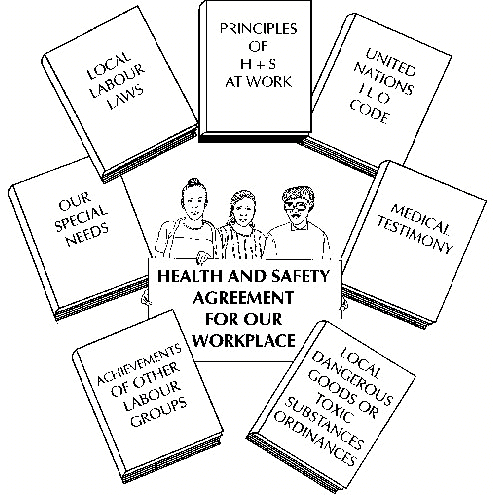 |
There are many health and safety topics that your union can promote through negotiations and then add to existing contract language. Choose the issues that are relevant and important in your workplace. Here are a few issues, which, if bargained successfully, could result in health and safety improvements at work:
The following is an example of health and safety contract language that was established through the collective bargaining process.
|
Article 21 — Safety, health and security
Article 15 — Safety and health
Safety and sanitation
Special hazards Article 18 — Protective clothing
Safety boots
Safety equipment
Compensation/rehabilitation
First aid
|
 |
Points
to remember |
|
|
V. Role of the health and safety representative
Health and safety representative |
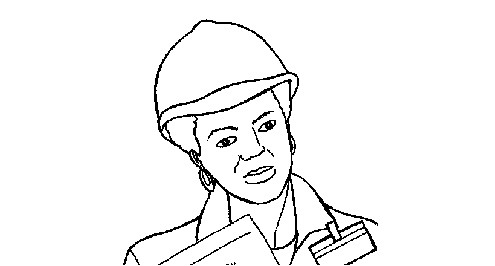 |
As a health and safety representative, it is important for you to know the workers' rights given by your country's health and safety legislation. Try to get a copy of the legislation and familiarize yourself with it. Other steps to help you reach goals towards creating, strengthening and using legislation are:
Work with your union to put pressure on the government to adopt or improve existing health and safety legislation. This should include provisions for adequate and effective enforcement.
Educate your co-workers about their rights under the law.
Work with your co-workers to identify limitations in your health and safety legislation. Develop strategies (short-term or long-term) for overcoming the limitations.
Develop and use check-lists to identify areas in the workplace that are out of compliance with existing regulations.
Use collective bargaining to work toward more immediate improvements in working conditions.
Work with the union and the employer to correct health and safety problems. If your employer is unwilling to comply with existing regulations, then contact the local factory inspectorate and request assistance.
Try to find out if your country has ratified any of the International Labour Organization's occupational health and safety Conventions or any ILO Conventions that contain elements of health and safety. You can find out by contacting one of the international trade secretariats or your national or regional ILO office, or by writing to ILO headquarters in Geneva, Switzerland.
It is important to know your rights under the law. If your country does not have health and safety legislation, then your union may want to pressure the government to develop or adopt adequate legislation. If your country does have health and safety legislation, then your union may want to identify the limitations of the legislation and then pressure the government to strengthen the laws.
Strategies designed to make legislation more protective should include stronger enforcement of health and safety laws. Without strong enforcement, there is little motivation for many employers to comply with acts or regulations. Working at the policy level is generally a lengthy process but positive results can benefit all workers.
Check-lists and collective bargaining are two practical ways of using health and safety legislation to benefit workers. Both tools can yield results relatively quickly, compared with the time it may take to see any changes in national legislation.
Exercise. Developing a workplace check-list from health and safety legislation
 |
Note to the instructor For this exercise, you will need to obtain a number of copies of your country's health and safety legislation, if it exists. If it does not exist, you can use another section of your national, state or provincial legislation that applies to workers. If there is no suitable legislation, then use the health and safety section (or other section) of your union's contract language for this exercise. Give copies of the legislation or contract language to the trainees. You will also need a flipchart (or some large sheets of paper taped to the walls) and markers or a chalkboard and chalks. (Note: If you have no suitable legislation or contract language, you can use this exercise as a group discussion about priority issues that should be included in contract language or national health and safety legislation. The class can then develop an action plan listing the steps trainees can take to develop their ideas into action.) Try to prepare a summary sheet of the legislation in advance. This will be very useful to the trainees, particularly if all or most of them are from the same country or union. Give a copy of the summary sheet to each trainee at the beginning of this exercise. Decide which section of the legislation (or contract language) will be used for developing a check-list. Trainees should work in small groups of four to five people. Instructions Develop check-lists and identify limitations Ask the groups to read the legislation and write down questions, developing a check-list which they can use in their workplaces. Remind trainees to note the section of the legislation when they develop each question. As the groups develop the check-lists, they should also identify any limitations in the legislation. When the groups have completed their check-lists, ask a member of each group to read out loud a couple of the questions the group developed, including the section of the legislation the questions apply to. After all groups have spoken, discuss with the whole class the different ways they and their union(s) can use these check-lists in the workplace. Write the suggestions on a flipchart or chalkboard. Next, discuss the limitations in the legislation that trainees identified. Write these down on the flipchart. Develop an action plan The next step is to develop an action plan for strengthening the legislation. You can do this together as a whole class, or trainees can work on an action plan with their groups. Discuss the trainees' answers for their action plans. A questionnaire to use in developing an action plan is given on the next page. Note: Remind trainees that they should distribute their check-lists, put them in their union journal, give them to health and safety representatives and shop stewards, and display them in their workplaces. Distributing the check-lists will help workers to learn about their rights. Points for discussion
|
Action plan for improving health and safety legislation
1. What are the three most important limitations in the legislation?
(a) ............................................................................................................................................
.................................................................................................................................................
(b) ............................................................................................................................................
.................................................................................................................................................
(c) ............................................................................................................................................
.................................................................................................................................................
2. In what ways could these limitations be improved?
(a) ..........................................................................................................................................
.................................................................................................................................................
(b) ............................................................................................................................................
.................................................................................................................................................
(c) ..........................................................................................................................................
.................................................................................................................................................
3. What can your union do to bring about these improvements?
.................................................................................................................................................
.................................................................................................................................................
4. What are some of the potential barriers to improvements?
.................................................................................................................................................
.................................................................................................................................................
5. Can you suggest ways to overcome some of these barriers?
.................................................................................................................................................
.................................................................................................................................................